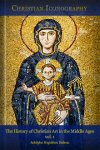Christian Iconography: The History of Christian Art in the Middle Ages (2 vols.)
Overview
Christian Iconography: The History of Christian Art in the Middle Ages provides a comprehensive introduction to the history of Christian art in the Middle Ages. Respected nineteenth-century French art historian Adolpe Napoleon Didron takes readers through the essential points of iconography and Christian art during this period. Beginning with a discussion of “Nimbus, or Glory,” Didron covers depictions of Jesus, the Cross, and the Holy Spirit, and then discusses the iconography of angels, devils, the soul, and much more. The text unpacks particular artistic elements and their development through time, and gives readers introduction to major artists, events, and movements crucial in the history of Christian art during the Middle Ages.
Readable, yet thorough, the detailed nature of this text offers readers an opportunity to more fully understand the rich history, tradition, and symbolism of religious art found in churches, museums, or other historical and cultural references. With ample illustrations and a helpful index to these illustrations, this text is a valuable resource for anyone looking to deepen their understanding of iconography. It’s also a great tool for gaining a cursory understanding of major themes and prominent styles found in Christian art produced between the fifth and fifteenth centuries.
In the Logos editions, these volumes are enhanced by amazing functionality. Scripture citations link directly to English translations, and important terms link to dictionaries, encyclopedias, and a wealth of other resources in your digital library. Perform powerful searches to find exactly what you’re looking for. Take the discussion with you using tablet and mobile apps. With Logos Bible Software, the most efficient and comprehensive research tools are in one place, so you get the most out of your study.
Check out Early Christian Iconography and a School of Ivory Carvers in Provence to expand your study of Christian art history further.

- Provides an introduction to the history of Christian art in the Middle Ages
- Discusses the development of iconography
- Uses numerous illustrations
Individual Titles

In this volume, Didron presents the history of the nimbus, the aureole, and the glory. He also discusses representations of the persons of the Trinity. Using numerous illustrations, Didron provides a detailed yet accessible introduction to the Christian art of the Middle Ages.

In the second volume of Christian Iconography, Didron continues his discussion of the history and representation of the Trinity. He then discusses the iconography of angels, devils, death, the soul, and the Christian Scheme. Using numerous illustrations, Didron provides a detailed yet accessible introduction to the Christian art of the Middle Ages. This volume also includes detailed appendixes and indexes.
Top Highlights
“Glory is constantly adopted by artists, both in painting and sculpture, as a characteristic ornament: it either encircles the head alone or the entire figure. As an attribute it serves to denote a holy person, in the same manner as the crosier or the sceptre distinguishes a bishop or a king. When this attribute enriches the head only it is called a nimbus. In this case it is analogous in signification to a crown, from which, however, it differs essentially in position if not in form. Both the crown and the nimbus are circular, but the former is placed horizontally on the head, the position of the latter is vertical.” (Volume 1, Page 22)
“The meaning of nimbus is the same as that of the Greek noun νιφάς; and it also signifies cloud, that is to say, the place in which are formed rain, hail, or snow, either of which may be intended by the Greek word.” (Volume 1, Pages 25–26)
“both usually impart the same idea, that of apotheosis, glorification, or deification” (Volume 1, Page 25)
“the graphic and dramatic arts became a book to those who could read no other.” (Volume 1, Page 6)
“Images speak,’ cries the eloquent apologist; ‘they are neither mute, nor lifeless blocks, like the idols of the Pagans. Every painting that meets our gaze in a church, relates, as if in words, the humiliation of Christ for his people, the miracles of the Mother of God, the deeds and conflicts of the Saints. Images open the heart and awake the intellect, and, in a marvellous and indescribable manner, engage us to imitate the persons they represent.” (Volume 1, Page 3)
- Title: Christian Iconography: The History of Christian Art in the Middle Ages
- Author: Adolphe Napoleon Didron
- Editor: Margaret Stokes
- Translator: E. J. Millington
- Publisher: George Bell and Sons
- Volumes: 2
- Pages: 1,054
Reviews
3 ratings
AeliusCicero
10/22/2014

Deacon Tim Johnson
9/29/2014

Bill Shewmaker
8/25/2014